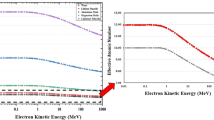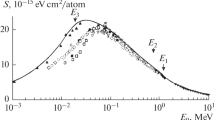Abstract
The stopping power in some biological compounds for electrons and positrons was calculated over the energy range from 100 eV to 1 GeV. Total stopping power was obtained by summing the electronic (collisional) and radiative stopping power of the target materials and then employing the continuous slowing down approximation (CSDA) to calculate the path length of incident particles in the target. An effective charge approximation was used for the calculation of collisional stopping power, and an analytical expression for the radiation length was applied to obtain the radiative stopping power. Calculations of stopping power and CSDA range were based mostly on analytical expressions, to allow for an easy calculation of these parameters. The results were tabulated and compared with available data.


Similar content being viewed by others
References
Akar A, Gümüş H (2005) Electron stopping power in biological compounds for low and intermediate energies with the generalized oscillator strength (GOS) model. Radiat Phys Chem 73:196–203
Akar A, Gümüş H, Okumusoglu NT (2007) Total electron stopping powers and CSDA-ranges from 20 eV to 10 MeV electron energies for components of DNA and RNA. Adv Quant Chem 52:277–288
Akkerman A, Akkerman E (1999) Characteristics of electron inelastic interactions in organic compounds and water over the energy range 20–10,000 eV. J Appl Phys 86:5809–5816
Amsler C, Doser M, Antonelli M et al (Particle Data Group) (2008) Review of particle physics (in Experimental Methods and Colliders). Phys Lett B 667:1–1340
Ashley JC (1988) Interaction of low-energy electrons with condensed matter: stopping powers and inelastic mean free paths from optical data. J Electron Spectrosc Relat Phenom 46:199–214
Ashley JC (1990) Energy loss rate and inelastic mean free path of low-energy electrons and positrons in condensed matter. J Electron Spectrosc Relat Phenom 50:323–334
Barkas WH, Dyer JN, Heckman HH (1963) Resolution of the Σ−-mass anomaly. Phys Rev Lett 11:26–28 (Erratum: Phys Rev Lett 11:138(1963))
Berger MJ, Seltzer SM (1982) Stopping powers and ranges of electrons and positrons. National Bureau of Standards Report NBSIR 82-2550 A
Bethe HA (1930) Zur Thorie des Durchgags Cehneller Karpuskularstrahlen durch Materie. Ann Physik 5:325–400
Bragg WH, Kleeman R (1905) On the alpha particles of radium and their loss of range in passing through various atoms and molecules. Philos Mag 10:318–340
Emfietzoglou D, Nikjoo H (2005) The effect of model approximations on single-collision distributions of low-energy electrons in liquid water. Radiat Res 163:98–111
Emfietzoglou D, Nikjoo H (2007) Accurate electron inelastic cross sections and stopping powers for liquid water over the 0.1–10 keV range based on an improved dielectric description of the Bethe surface. Radiat Res 167:110–120
Emfietzoglou D, Cucinotta F, Nikjoo H (2005) A complete dielectric response model for liquid water: a solution of the Bethe ridge problem. Radiat Res 164:202–211
Gümüş H (2005) Simple stopping power for low and intermediate energy electrons. Radiat Phys Chem 72:7–12
Gümüş H (2008) New stopping power formula for intermediate energy electrons. Appl Radiat Isot 66:1886–1890
Gümüş H, Kabadayı Ö, Tufan MÇ (2006) Calculation of the stopping power for intermediate energy positrons. Chin J Phys 44:290–296
Hogstrom KR, Almond PR (2006) Review of electron beam therapy physics. Phys Med Biol 51:455–489
ICRU (1984) Stopping powers for electrons and positrons ICRU Report 37. International Commission on Radiation Units and Measurements, Bethesda
ICRU (1989) Tissue substitutes in radiation dosimetry and measurement ICRU Report 44. International Commission on Radiation Units and Measurements, Bethesda
Lindhard J (1954) On the properties of a gas of charged particles. Dan Mat Fys Medd 28:1–57
Moadel RM, Nguyen AV, Lin EY, Lu P, Mani J, Blaufox MD, Pollard JW, Dadachova E (2003) Positron emission tomography agent 2-deoxy-2-[18F]fluoro-d-glucose has a therapeutic potential in breast cancer. Breast Cancer Res 5:R199–R205
Moadel RM, Weldon RH, Katz EB, Lu P, Mani J, Stahl M, Blaufox MD, Pestell RG, Charron MJ, Dadachova E (2005) Positherapy: targeted nuclear therapy of breast cancer with 18F-2-Deoxy-2-Fluoro-d-Glucose. Cancer Res 65:698–702
Nikjoo H, Uehara S, Emfietzoglou D, Cucinotta FA (2006) Track-structure codes in radiation research. Rad Meas 41:1052–1074
Peterson LR, Green AES (1968) The relation between ionization yields, cross sections and loss functions. J Phys B Mol Phys 1:1131–1140
Ritchie RH (1959) Interaction of charged particles with a degenerate Fermi-Dirac electron gas. Phys Rev 114:644–654
Rohrlich F, Carlson BC (1954) Positron-electron differences in energy loss and multiple scattering. Phys Rev 93:38–44
Salvat F, Fernández-Varea JM, Acosta E, Sempau J (2005) PENELOPE a code system for Monte Carlo simulation of electron and photon transport. NEA, Data Bank, France
Seltzer SM (1989) Electron and positron stopping powers of materials database version 2.0, NIST Standard Reference Database 7
Seltzer SM, Berger MJ (1985) Bremsstrahlung spectra from electron interactions with screened atomic nuclei and orbital electrons. Nucl Instrum Meth B 12:95–134
Seltzer SM, Berger MJ (1986) Bremsstrahlung energy spectra from electrons with kinetic energy 1 keV–10 GeV incident on screened nuclei and orbital electrons of neutral atoms with Z = 1–100. Data Nucl Data Tables 35:345–418
Sugiyama H (1985) Stopping power formula for intermediate energy electrons. Phys Med Biol 30:331–335
Tan ZY, Xia YY, Zhao MW, Liu XD, Li F, Huang BD, Ji YJ (2004) Electron stopping power and mean free path in organic compounds over the energy range of 20–10,000 eV. Nucl Instrum Meth B 222:27–43
Tan ZY, Xia YY, Liu XD, Zhao MW, Ji YJ, Li F, Huang BD (2005) Electron inelastic interactions in bioorganic compounds in the energy range of 20–10,000 eV. Appl Phys A 81:779–786
Tan ZY, Xia YY, Zhao MW, Liu XD (2006) Electron stopping power and inelastic mean free path in amino acids and protein over the energy range of 20–20,000 eV. Radiat Environ Biophys 45:135–143
Tsai Y-S (1974) Pair production and bremsstrahlung of charged leptons. Rev Mod Phys 46: 815–851 (Erratum: 49(4):421–423(1977))
Tufan MÇ, Gümüş H (2011) A Study on the calculation of stopping power and CSDA range for incident positrons. J Nucl Mater 412:308–314
Tufan MÇ, Köroğlu A, Gümüş H (2005) Stopping power calculations for partially stripped projectiles in high energy region. Acta Phys Pol A 107:459–472
Author information
Authors and Affiliations
Corresponding author
Rights and permissions
About this article
Cite this article
Tufan, M.Ç., Namdar, T. & Gümüş, H. Stopping power and CSDA range calculations for incident electrons and positrons in breast and brain tissues. Radiat Environ Biophys 52, 245–253 (2013). https://doi.org/10.1007/s00411-013-0457-x
Received:
Accepted:
Published:
Issue Date:
DOI: https://doi.org/10.1007/s00411-013-0457-x




